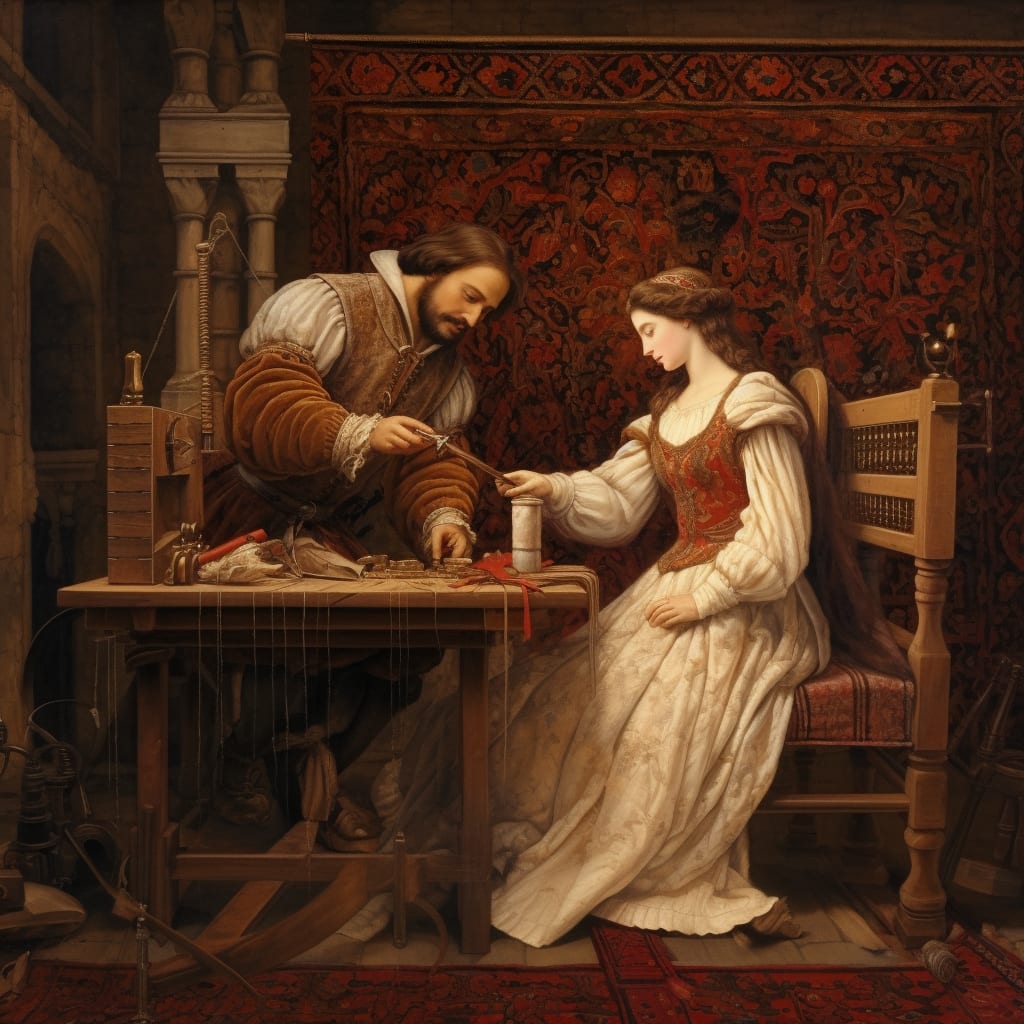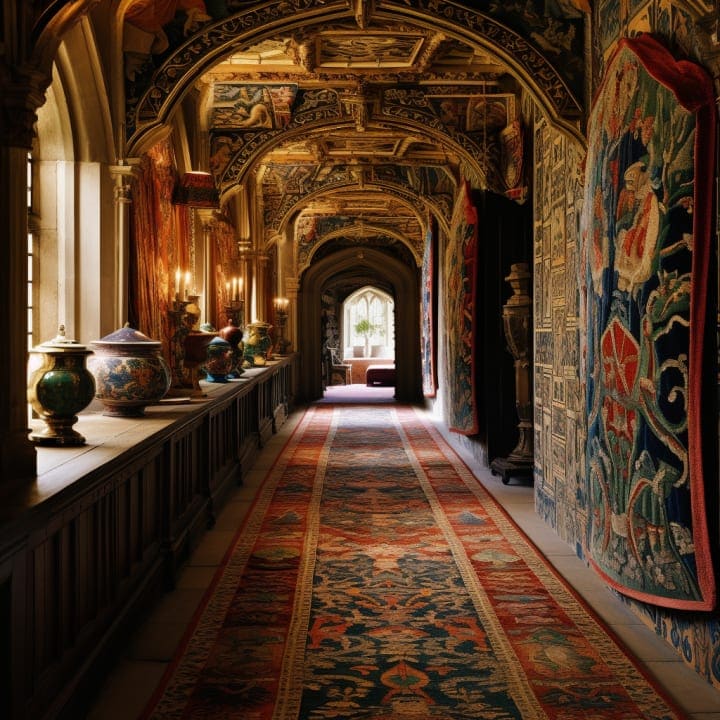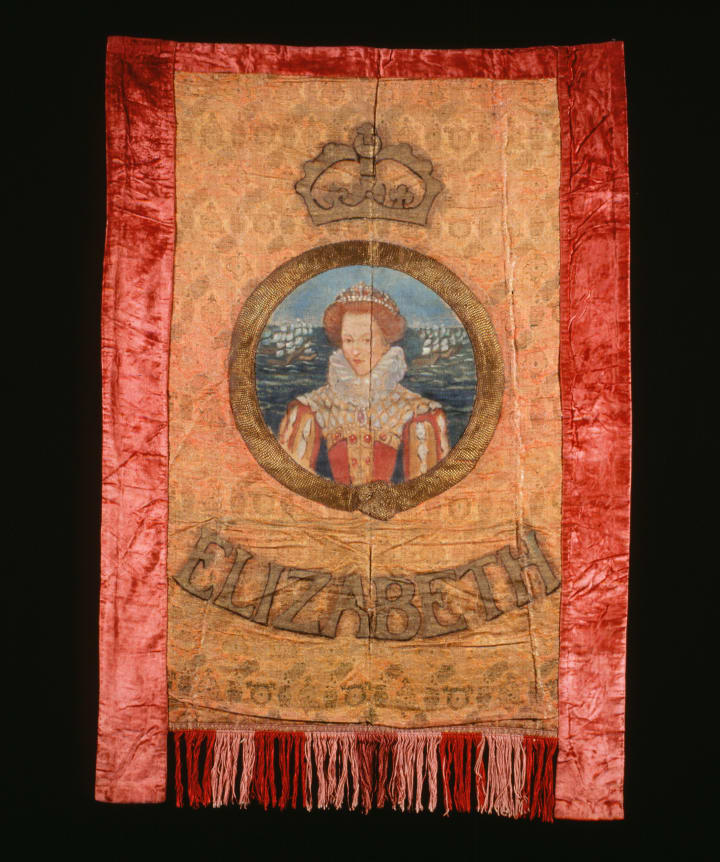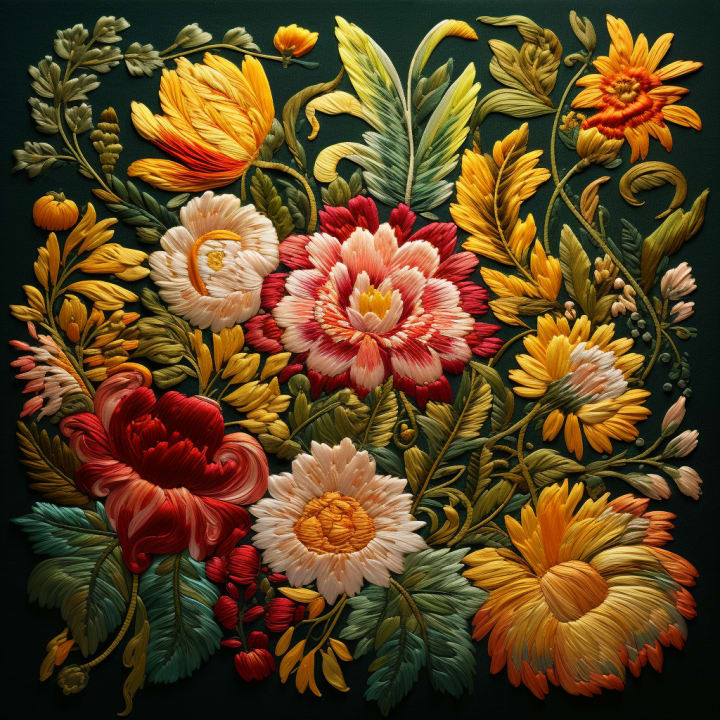They Called Her Tapestry
Alcester, England 1602

No one in the village had ever seen a girl so eager to get to her embroidery post as the auburn-haired 17-year-old who was out before dawn, hastily hurrying down the street.
"There goes Tapestry," the townsfolk would muse when hearing the familiar click-click of her worn boots on the cobblestones.
This early spring blue morning was no different.
She walked with an easy stride, taking in the cool air scented with the sweet smell of wood anemone which seemed to sprout up in every bare patch of damp earth.
"Ah, I hear Tapestry," John Astin, the baker, said to himself, looking up with a subtle smile from the kneading board before him.
"It's her again!" said Thomas Graystone, calling to his 5-year-old twin Roland, "It's Tapestry!" Roland immediately ran to the window and pressed his nose against the cold panes to see her better.
"She's a-goin' to work again," smiled Sarah Bailey as she stitched the hem on the linen tablecloths she was famous for in the town.
Tapestry walked all the way through the village and onto the unpaved country lane. The meadows and fields opened before her, filled with spring green blades of grass and splendid wildflowers of every color. Her eyes searched the landscape for the hues of this extraordinarily rich earth: blue columbine, golden kingcup, purple corncockle, and the delightfully scented small white bells known as lily-of-the-valley.
She still had a good distance to go, and she reveled in the scenery around her, noting the colors, the shapes of the petals and the play of light on the dew.
But like all of life, she had learned, no moment is perfect, and happiness is fleeting.
She heard the sarcastic laughter of Edmund Fry and his three trouble-making friends from the field.
"Well, well, if it isn't Lady Hoity Toity Tapestry, on her way to snob nob hall. Ha!"
Tapestry pretended she didn't hear and quickened her step.
Edmund and his cronies hastened theirs, getting nearer to her.
"Look at her, so high and mighty, she thinks she is too good to stop and speak with us."
"Me thinks she's scared, ooooo!" one of the bullies taunted.
"Must be that fancy egghead school she went to. Says she can write her name, but won't mingle with the likes of us. Pish posh! My X is as good as those squiggly lines she pretends to write!"
Edmund's buddies began to snicker.
She walked faster.
The distant sound of horse hooves suddenly grew louder behind her. She turned around.
Richard Carlton was riding tall on his tawny mare, supervising his fields.
He shouted:
"Hey, you poltroons, get back to work!"
The four young men quickly dispersed and disappeared into the fields.
Tapestry was much too embarrassed to say anything but nodded to the landowner her gratitude, and he tipped his hat to her.
She hastened on her way.
Her destination was the new development outside town: the tapestry works set up some years before by the Sheldon family of Barcheston. When she took the final bend of the lane, she marveled at the grand building before her.
She appeared small standing before the great carved oak front doors.
She entered the manor house's long, dignified hallway quietly and with a sense of awe. No matter how many times she came, this feeling never left her. How did she ever manage to end up with the good fortune to work in such a place? There were rooms for every department: woven tapestry, rug weaving, general embroidery, specialized embroidery.

That was her post: Specialized. She liked that word. She had shown such talent in her first year as an apprentice, that she was quickly assigned to this department. She turned left down the hallway and then slowly opened the door to the room where she would be found working six days every week.
She almost instinctively tiptoed to her place at the long wooden table, feeling as though she were entering someplace sacred, like a chapel or a cathedral.
In silence, she picked up the silver needle and held it to the light.
She chose her colors carefully, handling the silken threads with delicacy. With deliberate command, she began sewing precise, prismatic stitches.
Little by little she settled into the rhythm of her work, and slowly her mind began to grow quiet. She concentrated on a design of her own creation: subtly iridescent flowers; a play of lustrous, changing colors.
She could stitch the most lifelike and exquisite blooms with a skill not seen by many who surpassed her in age and experience.
As she stitched, she began to feel a deep sense of calm, aware of her breath and her heartbeat. The stitches took form, the images became clear, and her mind was at peace. "Ah, there it is again," she sighed to herself. "Sweet silent thought." This was the only time and place where she could so gently bring herself to such an inner state.
Sweet silent thought.
Even at her age there had already been much in her life to trouble her young mind.
Above all, the plague.
That dreaded word. And too often, it hit with a fury, shutting down shops and schools and sending folks to their homes to hide for months on end.
Just a few short years before, the plague had taken nearly a fifth of her village, including her own Hal, dear little brother. "Only seven years old," she would muse sadly, shaking her head as if still in disbelief. When she thought too long on the days before his death─the fever, the blisters, the horrible cough─a terrible pain hit her deep within her chest. It was as if she were reliving the unbearable loss all over again.
Sarah Bailey was left a widow and had to make a living stitching from home, becoming known for the quality of her linen work. "That is why it is always good for a woman to know needlework," her father told Tapestry when he had her apprenticed at 15 to the embroidery department at the Sheldon manor house.
The quiet and well-loved local baker John Astin had lost his wife and only son. Next door to him, the Graystone twins were just babies when their father died.
So much death and loss to grieve and mourn in her small village.
It was especially hard for Tapestry when they closed her school during her last year of planned study.
At 14 she was to complete the grammar school education promoted by the Tudors, especially endorsed by Queen Elizabeth, who had ruled now for more than 40 years. Each morning at school, Tapestry had paused before the Queen's portrait hanging on the stone walls. She would look at the royal image, with the fleet of naval ships at sea in the background, and remind herself:
"If a woman can rule a kingdom, a woman can do anything."

Boys as well as girls, no matter their background, were eligible to attend the local school, provided, of course, that they were not needed for work in the fields or the shops.
Tapestry had done well at school and prided herself in the poetry she could read, write, and recite by heart, in English as well as Latin. She was devasted when the school closed for so long due to the plague. She could neither see her friends nor complete her final year.
But once again, she turned her thoughts to her work. The concentration on her task helped her redirect her grief, transmuting it into color, shape, form, and meaning.
Suddenly, there was excited talk in the hallway.
"A new edition must have come out," she thought to herself.
All the workers looked forward to the weekly publication of a folio of new poetry and scenes from the latest plays.
"Maybe there is another sonnet from Will," she thought. The work of William Shakespeare was so beloved throughout the region that locals were fond of referring to him in familiar terms, even if they were not social acquaintances. "Perhaps there is another scene from Romeo and Juliet," she hoped. These days, during their midday meal break, that new play provoked all sorts of animated speculation among the workers. "Could love at first sight be true?" they all wondered. And each young textile worker perhaps secretly hoped it would one day be true for them.
But no, it was not a new publication that was the source of the fuss today.
The door opened suddenly. It was the master of the house, Ralph Sheldon.
"We have a visitor," he announced. "And he wishes to see your work," looking directly at Tapestry, who could hardly move, so startled and surprised she was at the rare appearance and incredible announcement.
"Bring your latest completed work and follow me," he barked.
Struggling to think, she reached for the black velvet embroidery she had finished just days before.

She followed the tapestry master down the hallway to a small room.
There, on a wooden table, she saw various implements and materials that she did not recognize: fabric and felt of various colors, yarn, threads, metal tools, and astonishingly, what almost seemed to be...
Could it be?
...Weapons!
Daggers, of all things!
"Sit here and wait quietly," Sheldon commanded, pointing to a chair near the table.
Her heart was beating fast, and a million thoughts raced through her mind.
What was this all about? Who wanted to see her? Did she do something wrong? She reviewed her recent actions and felt baffled at what on earth she might have done to warrant such an interview and a likely reprimand.
And then, as she looked at the mysterious arrangement of items on the table, it occurred to her that these were not simply random and strange items. They were props for the stage! The materials were in various stages of being made into costumes. Her worry and confusion quickly changed to curiosity as she looked at the colors and textures and the myriad objects before her.
The door creaked open.
A rather tall, stately man, with brown hair and beard, elegantly dressed in linen and silk, walked in.
She had never met him before, but she knew instinctively who he was.
She stood and made a slight curtsy, bowing her head, feeling at a loss as to what to say.
He seemed to sense her feelings and with a soft, sonorous voice said:
"I know your father."
"Yes, sir," she replied, remembering that her father had told her on various occasions that his services had been commissioned by the Globe Theater for costume designs.
"Your father is a most excellent tailor," the gentleman continued. "And he tells me his daughter has been commended for her skills in fine embroidered floral designs. Shall we sit for a moment together?"
She could feel her cheeks grow warm as she sat on a chair near this extraordinary visitor.
"I have also heard," he continued, "that you are very taken with the play, Romeo and Juliet."
"We all are, sir," Tapestry answered. "We often discuss the scenes and the dialogue when we have our midday meal together."
He smiled with a gentle look in his eyes.
"May I see a sample of your work?"
She unfolded the black felt fabric and revealed the glorious floral pattern, bright with color and light. He touched it with such delicacy that Tapestry found herself moved by his tender manners.
"Tell me, please," he said, "What goes through your mind when you are creating such a thing of beauty?"
She hesitated a moment and then replied:
"I find myself in a place of sweet silent thought."
He smiled softly.
"Sweet silent thought," he repeated. "I like the sound of those words."
They then began to converse on many subjects, easily, as if they had always known each other and had always spoken together.
She described her daily walks through the fields and the marvelous way the light danced on the dewy grass and colorful blooms. She would plan her new designs and imagine the shapes and textures she could create with the right combination of silk threads.
He talked of growing up in Stratford and the great thrill he had when his father, then mayor of Stratford, took him to see the new theatrical performances when the traveling players came to town. He remembers being very small and sitting on his father's lap in the front row. How proud he felt! How wonderful the cast and costumes and action of the play! He laughed when he recalled that his favorite part was the all-important sword fight culminating in nearly every play.
She listened so attentively, enthralled with this unimaginable moment and easy conversation.
She blushed a bit when she admitted that her favorite scene was Romeo below the balcony, looking up and saying,
"But soft! What light through yonder window breaks? It is the East, and Juliet is the sun!"
They felt so at ease that they even began to share some of their deepest sorrows.
She told him about Hal and how painful it was each time memories came back of his last days on earth. She struggled with questions that had no answers: Why so much suffering? Who decides who lives and who dies? Is everything really divinely ordained?
He understood. Her pain, her questions, the not-knowing of life's losses. His whole demeanor communicated that he understood.
He told her of his own boy, Hamnet, only 11 years old, who had died the same year as Hal. A shadow crossed his face as he spoke, and they sat for several minutes together, looking down, not speaking.
When at last he did speak, he said with great tenderness:
"Hamnet's twin sister, Judith, is the same age as you."
They spoke of their work, their hopes, and dreams.
He described some new writings he was working on and asked Tapestry what she thought. She was astounded that he wanted to know. "He cares what I think!" she said to herself. "How extraordinary!"
Perhaps for the first time in her life, Tapestry felt acknowledged. He listened to her and valued what she thought. He seemed to notice who she was as a person. She could not recall that ever happening before. So often she had experienced how young women were brushed aside as if they were a nuisance, not someone whose thoughts and ideas mattered.
Her courage grew as they spoke, and she dared to tell him her most secret wish:
"I hope someday to be able to work on one of the great looms here in Sheldon Hall. To design and weave a wonderfully grand wall tapestry. It would have kings and queens and forests and fields and horses and sheep." The excitement in her voice grew as she spoke. "And all sorts of people: mothers and fathers in the homes and farms and shops, and children in the schools and playing in the gardens, and churches and, and, and everything in the villages! I want to weave the tale of Warwickshire, of these times and this place. A tapestry that will survive for a thousand years!"
Her eyes glimmered with emotion as she spoke.
His brown eyes looked into hers with a knowing and a kindness she had never experienced before.
Before he left, he told her he planned to speak with Ralph Sheldon asking that she be commissioned to embroider the dress of Juliet for the production in London later that summer. Then he bowed politely and left, leaving her wondering if this had really happened, or if it were a dream.
A week passed by.
A happy, glorious week.
She almost skipped down the country lane to work every day as she dreamed of the design she would create, the glorious dress that Juliet would wear, the dreams and hopes she had shared, and the man she had met.
On the eighth day, when she arrived at her work table, she found a note.
Written on parchment with a beautiful scrolling cursive, it began:
For T
From WS
And as she began to read, she realized it was a sonnet:
When to the sessions of sweet silent thought
I summon up remembrance of things past
Her eyes lingered over the words.
The perfect rhythm and rhyme of the poetry wove together a tapestry of written words: sorrows, death, tears and grief recalled in quiet moments; regrets, grievances, and love lost to time. Memories of the pain of the past, as if never grieved before:
The sad account of fore-bemoaned moan,
Which I new pay as if not paid before.
But it was the ending, oh, the ending, that sent a current down her spine, the thrill of a transcendent connection, inexplicable, something absolutely new:
But if the while I think on thee, dear friend,
All losses are restored, and sorrows end.
Tapestry sat silently for a moment, not finding words for what she felt.
She reread the last lines two or three more times, wishing they would never end.
Then, very carefully, she stored the parchment in a safe place.
She picked up her silver needle.
With quiet determination and no small measure of joy, she returned to her work.
*
Historical notes:
From medieval times until the Tudor age in Europe, the most celebrated form of expressive and figurative art was tapestry.
It surpassed painting as the most commissioned art form by royalty and nobles for many centuries.
The vast majority of tapestry weavers and embroiderers were unnamed women, unknown to history.
Alcester is a market town found in the Stratford-on-Avon district in Warwickshire, England.
Barcheston is a village and civil parish in the Stratford-on-Avon district where Sheldon Tapestry Works was founded around 1580. They produced exquisite tapestries, many of which are on display to this day in museums and universities throughout Britain.
Stratford-upon-Avon was the birthplace of William Shakespeare.
He was 38 at the time of this story and already well-established as a published poet and playwright.
Many of his plays were performed at The Globe Theater where he was not only a playwright but director and shareholder. Performances in those times did not use a lot of stage design, but they did rely on very elaborate costumes, of the finest materials and craftsmanship.
Shakespeare became so successful as an actor, poet and, above all, playwright that he was able to purchase land and a large manor house on the edge of Stratford and retire in his late 40s, a wealthy man. Some scholars compare his wealth to that of a millionaire in our times.
He applied for and received a coat of arms, thus elevating the Shakespeare family from the status of craftsmen to that of gentry.
He completed grammar school but never attended university.
His plays continue to be performed around the world to this day.
Elizabeth I, Queen of England and Ireland, died in 1603, one year after the setting of this story. She reigned for more than 40 years and was often called "Good Queen Bess" by her people. Portraits of the queen, like the wall hanging mentioned and pictured in this story, were common during her reign in public buildings as well as people's homes.
The Plague, also known as the Black Death, scourged Europe from 1331 to 1770. There are still outbreaks today, primarily in Africa. Fortunately, due to advances in modern medicine, this deadly disease can be treated with antibiotics.
Sonnet 30 by William Shakespeare is one of his greatest works, where you can deepen into "sessions of sweet silent thought."
For further study, here are two excellent resources:
Book: Will in the World: How Shakespeare Became Shakespeare, by Stephen Greenblatt.
Video series: Shakespeare Uncovered, available on PBS.
About the Creator
PK Colleran
I love the music of words and the stories they tell.
Editor of bilingual poetry collection Landscape of the Soul by Hipólito Sánchez
Translator of Living Consciously and Words Matter, by Jorge Waxemberg
Please visit more of my work here.
Enjoyed the story? Support the Creator.
Subscribe for free to receive all their stories in your feed. You could also pledge your support or give them a one-off tip, letting them know you appreciate their work.
Reader insights
Outstanding
Excellent work. Looking forward to reading more!
Top insights
Easy to read and follow
Well-structured & engaging content
Heartfelt and relatable
The story invoked strong personal emotions
Excellent storytelling
Original narrative & well developed characters
Compelling and original writing
Creative use of language & vocab
Expert insights and opinions
Arguments were carefully researched and presented
Eye opening
Niche topic & fresh perspectives
On-point and relevant
Writing reflected the title & theme







Comments (23)
This is wonderful. A weave of heart and history (sorry for the pun.. it just came out!) Excellent work. What a wonderful feminist tale. The details of it are exquisite. ❤
What a positively lovely story. The history lesson was an icing on the cake. I never thought of tapestry in this way before, very informative and interesting work.
Very good. Congratulations on top story
This is very beautiful. I enjoyed the way that you made the Tapestry come to life, and I enjoyed the images that were conjured in my mind through your description of how a Tapestry is put together. This is a beautiful illustration using words. Well done!
Congratulations on the Top Story! ❤💖💓💚🤦♂️
Your writing is so pretty. Loved the historical notes to enhance the experience.
I really enjoyed the story and the context at the end was a great addition!!
I felt like I was standing in the room overhearing the conversation between Tapestry and Will. Your expressive style of writing, using all our senses, draws you into the story, and makes you feel like you know the characters and the town they’re living in. Your AI designed pictures are extraordinary! Ending with the historical facts of that time period, adds to the understanding of how important tapestry and needlepoint were in the story. I truly enjoyed your historical fiction story.
Very interesting! Great work!
This is a magnificent creation. Thank you for the historical overview and for spinning this wonderful piece!
Brilliant! Full of sensory imagery and enchanting!
Beautifully done!
Very good!
Nice
Lovely story and a perfect image
Very nicely done.
Love it! You might have just made me a fan of historical fiction. :)
‘In silence, she held the silver needle to the light.’ I must admit I have difficulty relating to historical fiction. But in 1 minute you have me hooked. I too embroider my freestyle designs. Such creatively soothing activities if only in snatched moments sustain me. I would love to see evolve into l a short story! Pauline 🌸
I would read a full length novel about Tapestry! Absolutely love the name, the setting, the embroidery! Wonderful job!
Speaking of fantastic last lines--this is it!! I really enjoyed this story and I'd love to know what happens next to Tapestry. You built a character I care about in just a few short words!
Oh my word, Bravo! I love the emotion this envokes.
This is nice, rags to riches good job Pk
This was good! Great job.